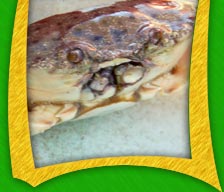


 |
||
CARIBBEAN SPINY LOBSTERS They vary in color from redish-orange to a darker orange-brown. They can be identified by the multiple yellow spots on their tails. These lobsters are found in warmer waters such as the Caribbean . They are social creatures living in rocks crevices and on coral reefs. Spiny lobsters feed on snails, clams, crabs, sea urchins or dead animal matter.
STONE CRABS Their most prominent feature is their large claws which are different sizes and have black tips. You can find stone crabs on bottoms of bays, oyster reefs and rock jetties where they can burrow or find shelter from predators. Stones crabs hunt by burrowing under the mud and waiting for their prey; they feed on oysters, small mollusks and other crustaceans.
Resources for this article have been provided by Wikipedia, the US Fish and Wildlife Service and the Florida Fish and Wildlife Conservation Commission. |



